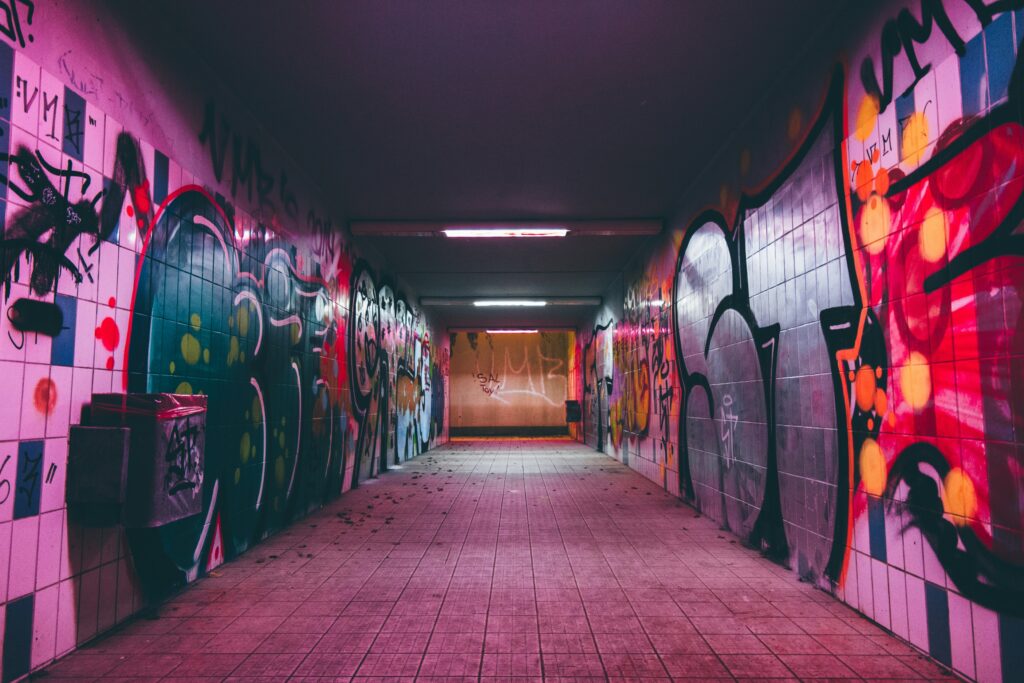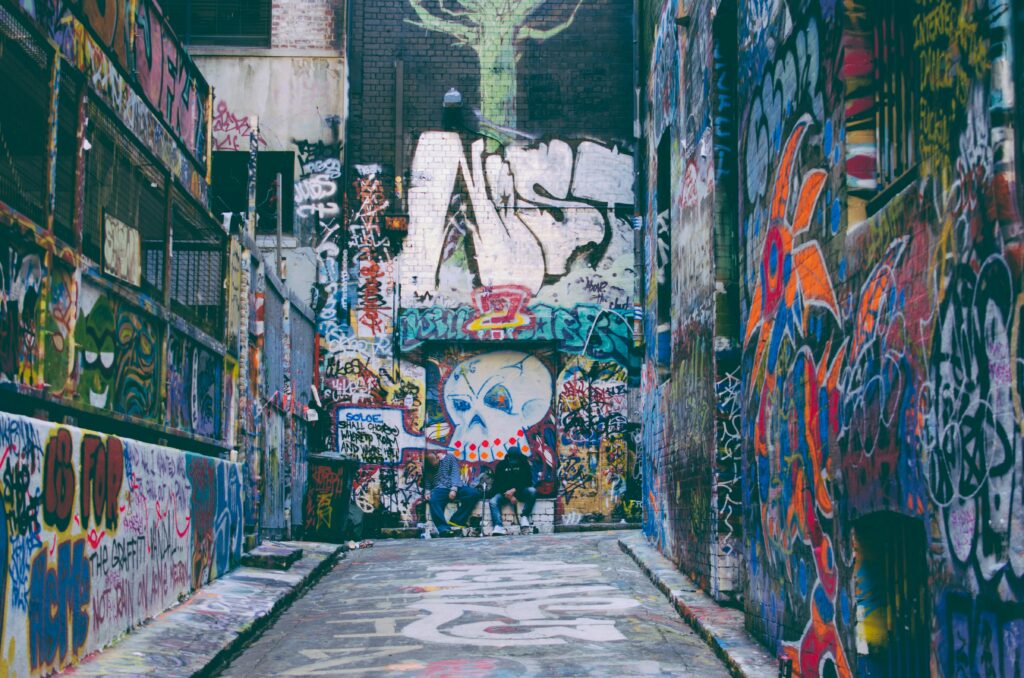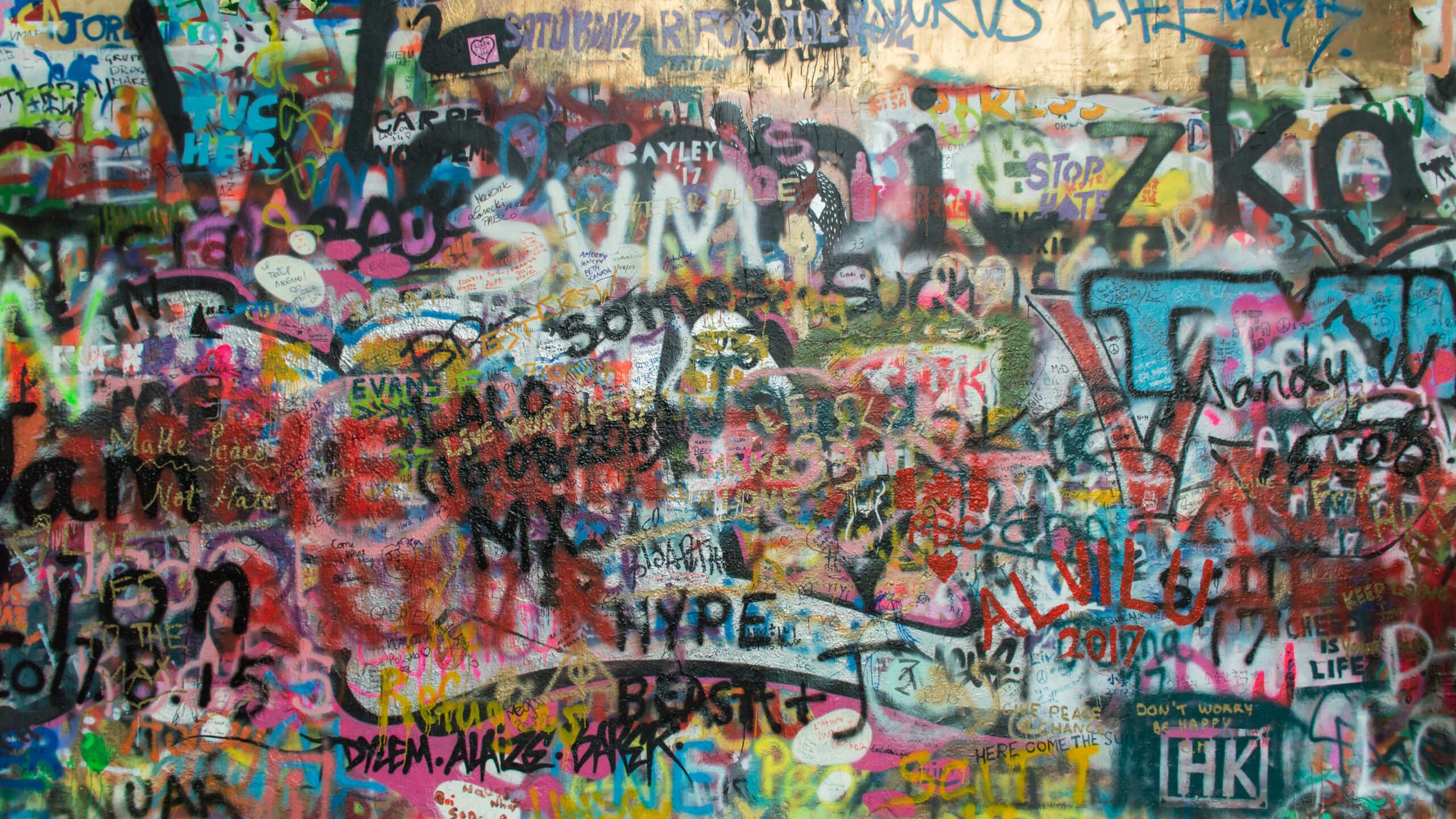Once dismissed as vandalism, street art has become a vibrant global phenomenon, transforming public spaces and sparking conversations. This article explores the history and evolution of street art, examining its diverse styles, the artists who define it, and its impact on urban landscapes and cultural discourse.
From Walls to Galleries: A History of Street Art
The roots of street art can be traced back to ancient civilizations, where graffiti was used for communication and artistic expression. However, the modern street art movement is generally considered to have emerged in the late 1960s in Philadelphia and New York City. Here’s a glimpse into its evolution:
- Early Stages: Markers and Stencils (1960s-1970s): Pioneers like Cornbread and TAKI 183 began leaving their signatures and social commentary on urban walls using markers and stencils.
- The Rise of Graffiti Culture (1970s-1980s): Graffiti crews emerged in major cities, using spray paint to create elaborate murals and compete for fame. Keith Haring and Jean-Michel Basquiat rose to prominence during this era.
- Beyond Tags: Muralism and Stencil Art (1980s-present): The movement expanded beyond simple tags to incorporate large-scale murals, stencils, and wheatpastes. Artists like Banksy and Shepard Fairey gained international recognition.
- Street Art Goes Global (1990s-present): Street art spread worldwide, becoming a powerful tool for social and political commentary. Artists like Blek le Rat and Fafi utilize stencils for their impactful messages.
- Digital Influence and Street Art 2.0 (2000s-present): The rise of social media has amplified the reach of street art, blurring the lines between street and gallery art. Artists like JR and Swoon explore interactive installations and engage with online communities.
A Canvas of Styles: The Diverse Forms of Street Art
Street art encompasses a vast array of styles and techniques:
- Stencil Art: Pre-cut designs are sprayed onto surfaces, creating detailed and often politically charged messages.
- Wheatpasting: Posters made from paper or wheat paste are adhered to walls, often showcasing bold imagery or social commentary.
- Murals: Large-scale paintings on building walls, ranging from photorealistic portraits to abstract compositions.
- Yarn Bombing: Urban landscapes are transformed using colorful yarn installations, adding a playful and whimsical touch.
- Street Installations: Three-dimensional elements are incorporated into street art, creating interactive experiences that push the boundaries of the medium.
From the Underground to the Mainstream: The Impact of Street Art
Street art has transcended its origins as underground counterculture, impacting the world in several ways:
- Urban Beautification: Drab and neglected urban spaces can be transformed into vibrant canvases, fostering a sense of community pride and deterring vandalism.
- Social Commentary: Street art can be a powerful tool for social and political critique, raising awareness about critical issues and sparking conversation.
- Cultural Expression: Street art provides a platform for marginalized voices and artistic expression outside of traditional art galleries.
- Blurring the Lines Between High and Low Art: The rise of street art challenges traditional definitions of art and democratizes access to artistic expression.
- Economic Opportunities: Street artists are increasingly recognized commercially, attracting gallery representation and even commissioned work.

Beyond the Walls: The Future of Street Art
Looking ahead, we can expect street art to continue evolving:
- Technological Integration: Street artists might utilize augmented reality or interactive elements to create immersive experiences that engage with technology.
- Community Collaboration: Street art projects could become even more collaborative, involving local communities in the design and creation process.
- Evolving Styles: New techniques and mediums will be incorporated, pushing the boundaries of street art and creating visually stunning and thought-provoking works.
- Global Dialogue: Street art will continue to be a powerful tool for global communication, fostering dialogue about shared human experiences and challenges.
A Legacy of Transformation: Street Art as a Force for Change Street art has come a long way, from rebellious markings on walls to a recognized art form with global reach. By transforming public spaces, prompting conversation, and providing a platform for social commentary, street art has become an undeniable force in the contemporary art world. As the movement continues to evolve, one can only anticipate the innovative ways street artists will continue to transform our cities and challenge our perspectives.
Once dismissed as vandalism, street art has become a vibrant global phenomenon, transforming public spaces and sparking conversations. This article explores the history and evolution of street art, examining its diverse styles, the artists who define it, and its impact on urban landscapes and cultural discourse.
From Walls to Galleries: A History of Street Art
The roots of street art can be traced back to ancient civilizations, where graffiti was used for communication and artistic expression. However, the modern street art movement is generally considered to have emerged in the late 1960s in Philadelphia and New York City. Here’s a glimpse into its evolution:
- Early Stages: Markers and Stencils (1960s-1970s): Pioneers like Cornbread and TAKI 183 began leaving their signatures and social commentary on urban walls using markers and stencils.
- The Rise of Graffiti Culture (1970s-1980s): Graffiti crews emerged in major cities, using spray paint to create elaborate murals and compete for fame. Keith Haring and Jean-Michel Basquiat rose to prominence during this era.
- Beyond Tags: Muralism and Stencil Art (1980s-present): The movement expanded beyond simple tags to incorporate large-scale murals, stencils, and wheatpastes. Artists like Banksy and Shepard Fairey gained international recognition.
- Street Art Goes Global (1990s-present): Street art spread worldwide, becoming a powerful tool for social and political commentary. Artists like Blek le Rat and Fafi utilize stencils for their impactful messages.
- Digital Influence and Street Art 2.0 (2000s-present): The rise of social media has amplified the reach of street art, blurring the lines between street and gallery art. Artists like JR and Swoon explore interactive installations and engage with online communities.
A Canvas of Styles: The Diverse Forms of Street Art
Street art encompasses a vast array of styles and techniques:
- Stencil Art: Pre-cut designs are sprayed onto surfaces, creating detailed and often politically charged messages.
- Wheatpasting: Posters made from paper or wheat paste are adhered to walls, often showcasing bold imagery or social commentary.
- Murals: Large-scale paintings on building walls, ranging from photorealistic portraits to abstract compositions.
- Yarn Bombing: Urban landscapes are transformed using colorful yarn installations, adding a playful and whimsical touch.
- Street Installations: Three-dimensional elements are incorporated into street art, creating interactive experiences that push the boundaries of the medium.
From the Underground to the Mainstream: The Impact of Street Art
Street art has transcended its origins as underground counterculture, impacting the world in several ways:
- Urban Beautification: Drab and neglected urban spaces can be transformed into vibrant canvases, fostering a sense of community pride and deterring vandalism.
- Social Commentary: Street art can be a powerful tool for social and political critique, raising awareness about critical issues and sparking conversation.
- Cultural Expression: Street art provides a platform for marginalized voices and artistic expression outside of traditional art galleries.
- Blurring the Lines Between High and Low Art: The rise of street art challenges traditional definitions of art and democratizes access to artistic expression.
- Economic Opportunities: Street artists are increasingly recognized commercially, attracting gallery representation and even commissioned work.

Beyond the Walls: The Future of Street Art
Looking ahead, we can expect street art to continue evolving:
- Technological Integration: Street artists might utilize augmented reality or interactive elements to create immersive experiences that engage with technology.
- Community Collaboration: Street art projects could become even more collaborative, involving local communities in the design and creation process.
- Evolving Styles: New techniques and mediums will be incorporated, pushing the boundaries of street art and creating visually stunning and thought-provoking works.
- Global Dialogue: Street art will continue to be a powerful tool for global communication, fostering dialogue about shared human experiences and challenges.
A Legacy of Transformation: Street Art as a Force for Change Street art has come a long way, from rebellious markings on walls to a recognized art form with global reach. By transforming public spaces, prompting conversation, and providing a platform for social commentary, street art has become an undeniable force in the contemporary art world. As the movement continues to evolve, one can only anticipate the innovative ways street artists will continue to transform our cities and challenge our perspectives.
